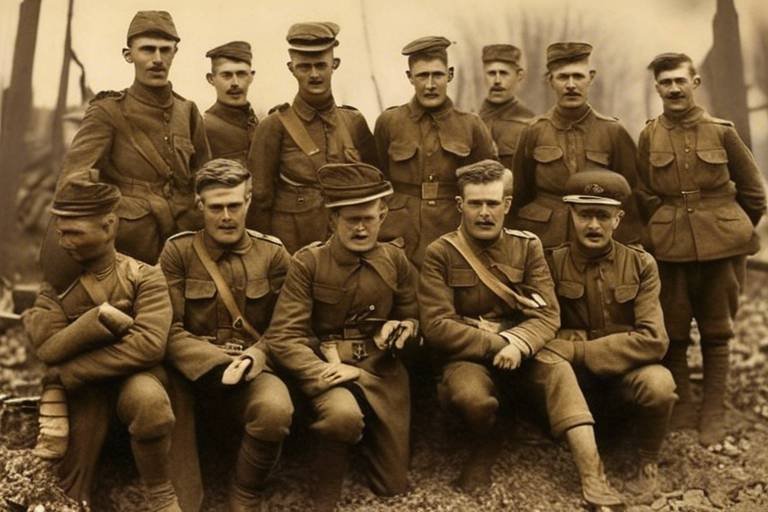Religion in Ancient Egypt - Gods and Beliefs
Religion played a central role in the ancient Egyptian civilization, shaping every aspect of daily life and influencing the culture, art, and governance of the society. The belief system of ancient Egyptians was polytheistic, with a vast pantheon of gods and goddesses that governed different aspects of nature, human life, and the afterlife. These deities were worshipped through elaborate rituals and ceremonies conducted by a powerful priesthood.
The ancient Egyptians revered gods such as Ra, the sun god and creator, Osiris, the god of the afterlife and resurrection, Isis, the goddess of magic and motherhood, Anubis, the god of mummification and the afterlife, and Horus, the god of kingship and the sky. Each deity had specific attributes and responsibilities, and their worship was essential for maintaining order and balance in the world.
The religious beliefs of ancient Egyptians were deeply intertwined with the concept of Ma'at, which represented truth, balance, and harmony. The Egyptians believed in an afterlife where the soul would undergo judgment before reaching the eternal paradise. To ensure a successful journey to the afterlife, elaborate burial customs such as mummification, tomb construction, and the inclusion of funerary texts like the Book of the Dead were practiced.
Temples were sacred spaces dedicated to the gods, where priests and priestesses performed daily rituals and ceremonies to honor the deities and maintain cosmic order. The priesthood held significant power and influence in ancient Egyptian society, acting as intermediaries between the people and the gods.
Ancient Egyptian religion also permeated the arts, architecture, and government of the civilization, with religious themes and symbolism evident in monumental structures like the pyramids and temples. The mythology and symbolism of ancient Egyptian religious texts and rituals provided insights into the cosmology and spiritual beliefs of the culture.
Despite the decline of ancient Egyptian religion due to foreign invasions and cultural changes, its legacy endured through the centuries, influencing subsequent civilizations and inspiring modern interpretations and revivals. Today, there are efforts to revive and reinterpret ancient Egyptian religious practices, with new religious movements drawing inspiration from the rich mythology and symbolism of the civilization.

Ancient Egyptian Gods
Topics to be discussed in the article include the various gods worshipped in ancient Egypt, the religious beliefs of the civilization, rituals and practices, temples and priesthood, burial customs, and the significance of religion in everyday life.
Ancient Egypt had a rich pantheon of gods, each playing a unique role in the religious beliefs of the civilization. Among the most prominent deities were Ra, the sun god; Osiris, the god of the afterlife; Isis, the goddess of magic and motherhood; Anubis, the god of mummification; and Horus, the god of kingship and the sky.
These gods were not just figures of worship but embodied different aspects of life and nature, reflecting the intricate mythology and spiritual beliefs of the ancient Egyptians.
In Egyptian mythology, each god had specific attributes and symbols associated with them, often depicted in art and hieroglyphics to convey their significance and power in the cosmic order.
The worship of these gods was central to the daily lives of the ancient Egyptians, with rituals, prayers, and offerings made to seek their favor and protection in various aspects of life.
The diverse pantheon of gods in ancient Egypt showcased the complex and interconnected nature of their religious beliefs, shaping the culture and worldview of the civilization.

Religious Beliefs and Practices
Ancient Egyptian religious beliefs and practices were deeply intertwined with the daily lives of the people, shaping their worldview and guiding their actions. Central to their faith was the concept of Ma'at, representing order, balance, and truth in the universe. The Egyptians believed that maintaining Ma'at was essential for a harmonious existence, both in this life and the afterlife. This belief influenced their moral code, social interactions, and even the governance of their society.
One of the most fascinating aspects of ancient Egyptian religion was their elaborate rituals and ceremonies. The practice of mummification, for example, was not just a funerary custom but a sacred ritual believed to preserve the soul for the journey to the afterlife. Offerings to the gods were another crucial part of their religious practices, with food, incense, and prayers being presented to the deities in temples as a sign of devotion and gratitude.
The afterlife held a prominent place in Egyptian religious beliefs, with the belief that the deceased would embark on a perilous journey to reach the Field of Reeds, a paradise-like realm of eternal bliss. To ensure a successful transition, the Egyptians meticulously prepared the dead through mummification, burial in elaborate tombs filled with treasures, and the inclusion of spells from the Book of the Dead to guide and protect the soul in the underworld.
Moreover, the ancient Egyptians worshipped a multitude of gods and goddesses, each representing different aspects of nature, society, and the divine realm. Among the most revered deities were Ra, the sun god; Osiris, the god of the afterlife; Isis, the goddess of magic and motherhood; Anubis, the god of mummification; and Horus, the god of kingship and the sky. These gods played vital roles in the religious mythology of Egypt, with stories and legends depicting their interactions and influence on human affairs.
Overall, the religious beliefs and practices of ancient Egypt were not just a set of rituals but a comprehensive system that governed every aspect of life. From birth to death, from farming to governance, religion permeated all levels of society, providing a framework for understanding the world and one's place in it. The legacy of Egyptian religious beliefs continues to fascinate and inspire people around the world, offering insights into the spiritual richness and complexity of this ancient civilization.

Temples and Priesthood
Temples and Priesthood played a central role in ancient Egyptian religious practices and beliefs. The temples were considered sacred spaces where the gods resided, and they were meticulously constructed with intricate designs and symbolic elements. The priests and priestesses who served in these temples were highly respected and held significant influence in society.
The temples were not only places of worship but also centers of administration, education, and cultural activities. They were often adorned with elaborate carvings, paintings, and statues depicting various gods and religious scenes. The layout of the temples was carefully planned to reflect the cosmological beliefs of the ancient Egyptians.
The priesthood in ancient Egypt was a hereditary position, with individuals inheriting their roles and responsibilities from their ancestors. Priests underwent rigorous training and were required to maintain purity through strict rituals and practices. They acted as intermediaries between the people and the gods, performing ceremonies, offering sacrifices, and interpreting divine messages.
Within the temples, priests conducted daily rituals to honor the gods, maintain order in the universe, and ensure the well-being of the community. These rituals often involved purification rites, offerings of food and incense, and recitations of sacred texts. The high priest held the most prestigious position and was responsible for overseeing all religious activities within the temple.
Additionally, priestesses played vital roles in temple ceremonies and religious festivals, representing the divine feminine aspect of the deities. They were often associated with fertility, healing, and protective roles within the community. The priesthood, both male and female, held significant power and authority in ancient Egyptian society.

Burial Customs and Afterlife
When it comes to ancient Egypt, one of the most fascinating aspects of their culture is their elaborate burial customs and beliefs about the afterlife. The ancient Egyptians held a deep reverence for death and the journey to the afterlife, believing that proper burial practices were essential for a successful transition to the next world.
Central to Egyptian burial customs was the practice of mummification, a complex process that involved preserving the body to ensure its integrity in the afterlife. The process of mummification was accompanied by rituals and prayers, with the belief that the soul would need the body in the afterlife.
Additionally, tomb construction was a crucial aspect of burial customs in ancient Egypt. The wealthy and elite members of society would commission elaborate tombs filled with treasures and provisions for the deceased to use in the afterlife. The most famous example of this is the tomb of Tutankhamun, with its vast riches and intricate burial chamber.
The ancient Egyptians also believed in the existence of the "Book of the Dead," a collection of spells and prayers that guided the deceased through the perilous journey to the afterlife. These texts were often inscribed on tomb walls or included in burial chambers to assist the soul in navigating the challenges of the underworld.
Furthermore, the concept of judgment in the afterlife was a central tenet of ancient Egyptian beliefs. According to their mythology, the heart of the deceased would be weighed against the feather of Ma'at, the goddess of truth and justice. If the heart was found to be pure and free of sin, the soul would be granted eternal life in the afterlife.
In essence, burial customs and beliefs about the afterlife were integral to ancient Egyptian society, shaping their views on death, rebirth, and the eternal journey of the soul. These practices not only reflected their religious beliefs but also underscored the importance of preparation and reverence for the transition to the next world.

Significance of Religion in Society
Religion in ancient Egypt held a profound significance in shaping the society and culture of the civilization. It was not just a set of beliefs and rituals but a fundamental aspect that permeated every aspect of daily life. The Egyptians viewed their gods as integral to maintaining order and balance in the world, with each deity representing different forces of nature and aspects of human existence.
The influence of religion extended beyond the spiritual realm, impacting various facets of society. Art and architecture were often dedicated to gods and goddesses, with temples serving as both religious centers and administrative hubs. The pharaoh, as the divine ruler, was closely tied to religious practices, emphasizing the interconnectedness of religion and governance.
Moreover, the religious calendar dictated the timing of agricultural activities, festivals, and rituals, highlighting the close relationship between religious observances and the agricultural cycle. The annual flooding of the Nile, essential for agriculture, was attributed to the benevolence of the god Hapi, underscoring the intertwining of religious beliefs with practical aspects of life.
Religious beliefs also played a crucial role in shaping social structure and morality in ancient Egyptian society. The concept of Ma'at, representing truth, balance, and order, guided ethical behavior and interpersonal relationships. Upholding Ma'at was not only a personal duty but a societal obligation, ensuring harmony and stability within the community.
Furthermore, the priesthood held considerable influence, acting as intermediaries between the people and the gods. Priests and priestesses performed rituals, offered prayers and sacrifices, and maintained the temples, reinforcing the importance of religious practices in maintaining cosmic order and divine favor.
Overall, religion in ancient Egypt was not just a set of beliefs but a comprehensive system that governed all aspects of life, from the spiritual to the practical. Its significance in society was profound, shaping the worldview, values, and daily interactions of the ancient Egyptians, and leaving a lasting legacy that continues to fascinate and inspire to this day.

Mythology and Symbolism
Mythology and symbolism play a crucial role in understanding the ancient Egyptian religious beliefs and practices. The myths surrounding gods and goddesses such as Ra, Osiris, and Isis are not merely stories but serve as symbolic representations of cosmic forces and principles. These deities embody various aspects of nature, the cosmos, and human existence, offering insights into the Egyptians' worldview and spiritual understanding.
Ancient Egyptian art and hieroglyphics are rich in symbolism, with each symbol carrying deep meaning and significance. The use of symbols in religious texts, temple decorations, and burial rituals conveys complex ideas about the afterlife, the divine order, and the eternal cycle of life and death. For example, the Ankh symbolizes life and immortality, while the Eye of Horus represents protection and healing.
Moreover, the mythology of ancient Egypt is not just a collection of fantastical tales but a structured system of beliefs that underpinned the religious practices and rituals of the civilization. The stories of creation, the battles between gods and demons, and the journeys of the deceased through the underworld are all part of a coherent cosmology that provided meaning and purpose to the Egyptians' lives.
Symbolism also permeated everyday objects and activities in ancient Egypt, from amulets and jewelry to agricultural practices and architectural designs. The intricate hieroglyphic inscriptions found in temples and tombs were not just decorative but held sacred meanings related to the gods, the pharaoh, and the deceased individual's journey to the afterlife.
Overall, the mythology and symbolism of ancient Egyptian religion offer a fascinating glimpse into a culture that saw the divine in every aspect of existence, from the movement of the sun and stars to the growth of crops and the cycle of birth and death. By studying these myths and symbols, we can gain a deeper understanding of the spiritual beliefs and values that shaped one of the most enduring civilizations in history.

Decline and Legacy
As ancient Egypt entered a period of significant change and turmoil, the once dominant religion began to wane in influence, leading to its eventual decline. Foreign invasions, such as those by the Persians and later the Romans, brought with them new religious beliefs and practices that challenged the traditional Egyptian pantheon. The conquest of Alexander the Great and the subsequent spread of Hellenistic culture further eroded the indigenous religious traditions of Egypt, paving the way for the eventual rise of Christianity as the dominant faith in the region.
Despite the decline of ancient Egyptian religion as a dominant force, its legacy continued to resonate through the centuries. The rich mythological and symbolic heritage of the civilization influenced later religious traditions, including Gnosticism and Hermeticism, which drew upon Egyptian cosmology and symbolism in their teachings. The concept of an afterlife, central to Egyptian beliefs, also found echoes in subsequent religious philosophies and continues to shape modern ideas about the soul and the journey beyond death.
Moreover, the architectural and artistic achievements of ancient Egypt, often inspired by religious motifs and themes, left a lasting impact on the cultural landscape of the world. The grand temples, intricate tombs, and elaborate funerary practices of the Egyptians served as sources of inspiration for later civilizations, influencing the development of art, architecture, and religious practices in regions far beyond the borders of Egypt.
While the formal worship of the ancient Egyptian gods may have faded into obscurity, their enduring legacy can be seen in the enduring fascination with Egyptian mythology and symbolism in popular culture. From movies and literature to fashion and design, the imagery of ancient Egypt continues to captivate and inspire, keeping alive the spirit of a civilization that believed in the power of gods and the mysteries of the afterlife.

Modern Interpretations and Revival
In the modern era, ancient Egyptian religion has experienced a resurgence of interest and reinterpretation. As scholars and enthusiasts delve deeper into the mysteries of this ancient civilization, new religious movements have emerged, seeking to revive the practices and beliefs of the past. These modern interpretations often blend traditional Egyptian mythology with contemporary spiritual practices, creating a unique fusion of ancient wisdom and modern sensibilities.
One of the key aspects of the revival of ancient Egyptian religion is the incorporation of its symbolism and rituals into various spiritual practices. From meditation techniques inspired by Egyptian hieroglyphs to the use of ancient deities as archetypes for personal growth, the influence of Egyptian mythology can be seen in a wide range of spiritual traditions today.
Furthermore, the legacy of ancient Egyptian religion continues to resonate in popular culture, with references to gods like Ra and Anubis appearing in movies, books, and video games. The enduring fascination with the mysteries of the pyramids and the afterlife reflects a deep-seated interest in the spiritual beliefs of this ancient civilization.
Contemporary scholars and archaeologists are also actively involved in uncovering new insights into ancient Egyptian religion, shedding light on previously unknown aspects of their beliefs and practices. Through ongoing research and excavation, we continue to deepen our understanding of this enigmatic culture and its profound spiritual legacy.
Overall, the modern interpretations and revival of ancient Egyptian religion serve as a testament to the enduring power of this ancient civilization's beliefs and practices. By blending the wisdom of the past with the innovations of the present, we honor the rich heritage of the Egyptians and keep their spiritual legacy alive for future generations to explore and appreciate.
Frequently Asked Questions
- What were the main gods worshipped in ancient Egypt?
Ancient Egyptians worshipped a pantheon of gods, including prominent deities like Ra, Osiris, Isis, Anubis, and Horus. Each god had specific attributes and roles in the religious mythology of the civilization.
- What were the core beliefs of ancient Egyptian religion?
Ancient Egyptian religion was centered around concepts such as Ma'at (truth, balance, order), the afterlife, and the importance of rituals like mummification and offerings to appease the gods.
- How did religion influence ancient Egyptian society?
Religion permeated all aspects of ancient Egyptian society, influencing art, architecture, government, and social structure. It shaped the worldview and values of the civilization.
- What were the burial customs of the ancient Egyptians?
Ancient Egyptians had elaborate burial practices, including mummification, tomb construction, and the use of texts like the Book of the Dead to ensure a successful journey to the afterlife.
- What led to the decline of ancient Egyptian religion?
The decline of ancient Egyptian religion was influenced by factors such as foreign invasions, cultural changes, and the rise of new belief systems, leading to a gradual fading of the traditional religious practices.


















